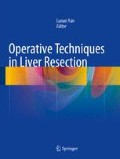Abstract
Liver resection has experienced more than 100 years of development as the primary treatment for HCC. To the end of the nineteenth century, the animal experiment research had shown that liver parenchyma incision is feasible. When the liver had been cut off three quarters, the animal was still alive. In 1888, Langenbuch, a German surgeon, successfully resected a tumor on the edge of the liver in a woman patient. Therefore, he was regarded as the first person who succeeded in resecting liver tumors. William Keen (1899) was considered as the first American surgeon in liver resection; he reported three successful surgical cases. However, the perioperative mortality (70–90 %) of liver resection was very high during that period [1]. One of the main reasons was that the blood loss in the surgery could not be effectively controlled. The control of hemorrhage during liver resection is very important for HCC patients, especially with cirrhosis, because the amount of blood loss and transfusion in the operation have been shown to correlate with morbidity, mortality, and long-term survival after operation [2–4].
Access this chapter
Tax calculation will be finalised at checkout
Purchases are for personal use only
References
Lai E, Fan S-T, Lo C-M, et al. Hepatic resection for hepatocellular carcinoma. An audit of 343 patients. Ann Surg. 1995;221(3):291.
Chikamoto A, Beppu T, Masuda T, et al. Amount of operative blood loss affects the long-term outcome after liver resection for hepatocellular carcinoma. Hepatogastroenterology. 2012;59(116):1213–6.
Katz SC, Shia J, Liau KH, et al. Operative blood loss independently predicts recurrence and survival after resection of hepatocellular carcinoma. Ann Surg. 2009;249(4):617–23.
Kusano T, Sasaki A, Kai S, et al. Predictors and prognostic significance of operative complications in patients with hepatocellular carcinoma who underwent hepatic resection. Eur J Surg Oncol EJSO. 2009;35(11):1179–85.
Pringle JH. V. Notes on the arrest of hepatic hemorrhage due to trauma. Ann Surg. 1908;48(4):541.
Man K, Fan S-T, Ng I, et al. Prospective evaluation of Pringle maneuver in hepatectomy for liver tumors by a randomized study. Ann Surg. 1997;226(6):704.
Weigand K, Brost S, Steinebrunner N, et al. Ischemia/reperfusion injury in liver surgery and transplantation: pathophysiology. HPB Surg. 2012;2012:176723.
Serracino-Inglott F, Habib NA, Mathie RT. Hepatic ischemia-reperfusion injury. Am J Surg. 2001;181(2):160–6.
Xiaobin F, Zipei L, Shuguo Z, et al. The Pringle manoeuvre should be avoided in hepatectomy for cancer patients due to its side effects on tumor recurrence and worse prognosis. Med Hypotheses. 2009;72(4):398–401.
van der Bilt JD, Kranenburg O, Nijkamp MW, et al. Ischemia/reperfusion accelerates the outgrowth of hepatic micrometastases in a highly standardized murine model. Hepatology. 2005;42(1):165–75.
Makuuchi M, Mori T, Gunven P, et al. Safety of hemihepatic vascular occlusion during resection of the liver. Surg Gynecol Obstet. 1987;164(2):155–8.
Wen T, Chen Z, Yan L, et al. Continuous normothermic hemihepatic vascular inflow occlusion over 60 min for hepatectomy in patients with cirrhosis caused by hepatitis B virus. Hepatol Res. 2007;37(5):346–52.
Yan L-N, Yuan C-X, Zhang. Z-D. Hepatopetal blood occlusion of half liver during hepatectomy in 29 patients [J]. Chin J Surg. 1994;32(1):35.
Author information
Authors and Affiliations
Corresponding author
Editor information
Editors and Affiliations
Rights and permissions
Copyright information
© 2016 Springer Science+Business Media Dordrecht
About this chapter
Cite this chapter
Yan, L.N., Liu, Z. (2016). Techniques of Vascular Inflow Occlusion and Liver Parenchymal Transection. In: Yan, L. (eds) Operative Techniques in Liver Resection. Springer, Dordrecht. https://doi.org/10.1007/978-94-017-7411-6_7
Download citation
DOI: https://doi.org/10.1007/978-94-017-7411-6_7
Published:
Publisher Name: Springer, Dordrecht
Print ISBN: 978-94-017-7409-3
Online ISBN: 978-94-017-7411-6
eBook Packages: MedicineMedicine (R0)

